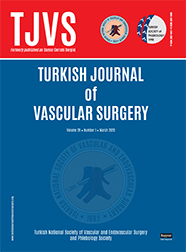
The Turkish Journal of Vascular Surgery
Yazarlar: Melih ÜRKMEZ, Muzaffer BAHÇİVAN, Mustafa Kemal DEMİRAĞ, Atilla SARAÇ, Hasan Tahsin KEÇELİGİL
Konular:-
Anahtar Kelimeler:Renal failure,Chronic,Renal dialysis,Catheterization
Özet: Background: Chronic renal failure is a frequently seen disease which has a high level of mortality and morbidity. The most frequent treatment methods attended for these patients are transplantation, hemodialysis and peritoneo-dialysis. In this article, it's aimed to declare our experiences on permenant tunneled dialysis catheter with taken from the data of the hemodialysis patients. Patients and Method: Between October 2003-January 2008, 385 permenant tunneled dialysis catheters are inserted to the 309 CRF patients who are under regular hemodialysis. 196 patients were women (63.4%) and 113 patients were men.(36.5%). The patients were aged between 10-82 and average age was 62.7. Five patients were under 18. Splitt, tunneled and cuffed permenant dialysis catheters are used on all of the patients. The processes were attempted under local anesthesia and with scopy. Results: The wrong localization of the catheter wasn't seen in any of the patients because of the usage of the scopy. The fibrinolitic treament had to be attempted on 66 (21%) patients for one time and for 12 (3%) patients for two times. The catheter had to be changed for one time on 28 patients (7.2%), two times on 10 patinets (2.5%), three times on 4 patients (1.2%), four times on 4 patients (1.2%). In the late term, catheters was changed on 26 patients ( 8.4%) because of infection. The open remaining times of the catheters were changed between 30 days and 2 and a half years. Conclusions: The permenant tunneled hemodialysis catheters are indicate on the cases in which not to be able to set up a HD application on the patients who have end stage renal faliure, on the cases for which HD should be applicated for the patient who have hemodinamic instability and short life expectation because of the additional diseases. The most suitable application for the insertion of the catheters is the right internal juguler vein by using Doppler USG and scopy. With this method, complication and mortality and morbidity rates will be decreased.